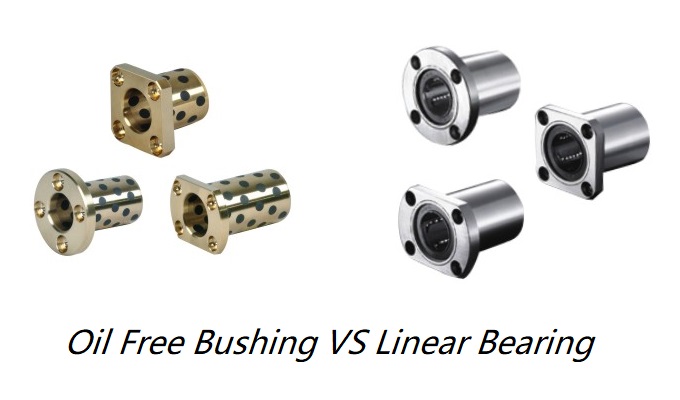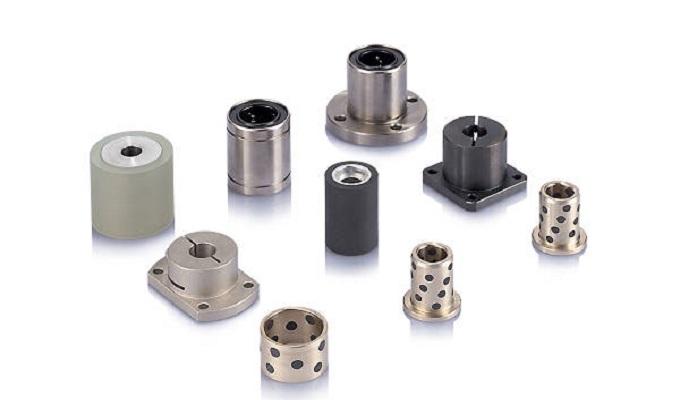Q: What is a linear bearing?
A: A linear bearing is a mechanical component used to facilitate linear motion. It is designed to support and guide loads along a linear path. Linear bearings typically consist of an inner and outer sleeve, sliding elements (such as balls or rollers), and a cage. They provide smooth and precise linear motion while bearing vertical and horizontal loads.
Q: What are the linear bearings types?
A: Rolling Linear Bearings: These use rolling elements (such as balls or rollers) to reduce sliding friction and enable smooth linear motion. Common types of rolling linear bearings include ball bushing bearings and roller bearings.
Sliding Linear Bearings: These bearings rely on sliding surfaces to support and facilitate motion. Examples of sliding linear bearings include coated bearings and lubricated bearings.
Air Bearings: Air bearings utilize compressed air to support and enable contact-free linear motion. They are commonly used in high-speed and high-precision applications such as optical equipment and semiconductor manufacturing.
Magnetic Bearings: Magnetic bearings utilize magnetic forces to support and control linear motion. They are often employed in high-speed and high-precision applications such as centrifuges and wind turbines.
Q: Can UU seal gaskets and sealing felt rings be installed on linear bearings together for dust prevention?
A: Yes, UU seal gaskets are typically already installed inside linear bearings. To install sealing felt rings, it is necessary to use support brackets and secure them with retaining rings. Sealing felt rings can also be installed on LM-type linear bearings (ranging from LM6 to LM100). Only UU seal gaskets can be used for other linear bearings models.

Q: Is it possible to apply surface treatment to linear bearings?
A: Surface treatment can be applied to certain models of linear bearings, but not all models may be suitable for surface treatment. When selecting surface treatment, please carefully refer to the relevant specifications and guidelines.
Q: How should linear bearings be installed?
A: When installing linear bearings, it is advisable to avoid using set screws to compress the outer surface of the bearing housing, as this can cause deformation of the housing. It is recommended to use retaining rings or retaining plates for fixation.
Q: What is the temperature range for using linear bearings?
A: The material of the cage primarily determines the temperature range for using linear bearings. Please refer to the diagram below:
|
Structure |
Material |
Maximum operating temperature |
|
Outer cylinder |
Stainless Steel 440C |
1070℃ |
|
Bearing steel |
500℃ |
|
|
Ball |
Stainless Steel 440C A |
1070℃ |
|
Bearing steel |
500℃ |
|
|
Cage |
Resin |
80℃ |
|
Steel cage |
120℃ |
|
|
Sealing ring |
Nitrile rubber |
120℃ |
In summary:
① Linear bearings are not suitable for use in high-temperature conditions (for high-temperature conditions, oil-free bushings are recommended).
② Depending on the temperature conditions, products with either a resin or steel cage can be chosen.
Q: What maximum temperature can the sealing felt ring inside the linear bearing withstand?
A: The sealing felt ring inside the linear bearing can withstand temperatures up to 120 degrees Celsius.
Q: Can linear bearings be used for rotational motion?
A: No, linear bearings cannot be used for rotational motion. Attempting to use them for rotational motion can lead to accidents.
Q: What materials are optical shafts made of?
A: Optical shafts are typically made of SUJ2, SK3-6, and S55C and are surface hardened through high-frequency quenching. They can also be made from corrosion-resistant martensitic stainless steel SUS440C.
Q: Is the surface hardness the same for every optical shaft?
A: The hardness of optical shafts is the same, but the depth of the surface hardness layer may vary depending on the diameter of the shaft.
Q: What is the expected lifespan of a linear bearing?
A: The lifespan of a linear bearing depends on several factors, including load, speed, operating environment, lubrication conditions, etc. Generally, the rated lifespan of a linear bearing refers to the anticipated lifespan of the bearing in more than 10% of cases, based on a specific load and standard operating conditions, with 1 million reciprocating cycles. However, the actual lifespan may vary depending on the specific operating conditions.
Q: How should linear bearings be lubricated?
A: Lubrication of linear bearings is important in ensuring proper operation and extending lifespan. Generally, the lubricating grease is used for lubrication, with common lubricating greases being AFB-LF grease and high-quality lithium soap-based grease No. 2. The grease should be regularly replaced and replenished according to the working conditions and manufacturer's recommendations.
Q: How can noise issues during the operation of linear bearings be resolved?
A: Noise issues during the operation of linear bearings can be caused by various factors, such as poor lubrication, impurities entering the bearings, wear, etc. The key to resolving noise issues is to identify the root cause of the noise and take appropriate measures. Common solutions include cleaning the bearings, replacing the lubricant, checking the seals, and adjusting assembly clearances.
Q: Are linear bearings suitable for high-speed motion?
A: Linear bearings are suitable for a certain range of motion speeds but not for high-speed motion. High-speed motion can generate significant friction, heat, and inertia forces, which may lead to overheating, damage, or vibration of the bearings. If high-speed motion is required, specialized bearings designed for high-speed applications should be chosen, and the manufacturer's recommendations should be followed.
Q: Is it necessary to perform regular inspections of linear bearings?
A: Regular inspections of linear bearings can help identify potential issues early and take appropriate maintenance measures to ensure their proper operation and extend their lifespan. Regular inspections should include aspects such as the appearance of the bearings, lubrication status, integrity of seals, and noise/vibration during bearing operation. Depending on usage, it is recommended to establish an appropriate inspection schedule, typically performed after each work cycle or annually.
Q: How waterproof are linear bearings?
A: In conditions where the equipment environment is relatively humid or there is splashing water, it is recommended to use linear bearings with outer cylinders made of nickel-plated bearing steel and resin retainers. The outer cylinder is rust-resistant, but what about the ball? When the equipment is running steadily, the balls are constantly in motion and cannot generate rust. Moreover, applying lithium soap-based grease as a lubricant before use also provides a certain rust-prevention effect.

Q: What is the dust protection rating of linear bearings?
A: The characteristics of linear bearing products make providing an exact dust protection rating difficult. However, linear bearings with nitrile rubber seals (which have excellent oil resistance, good wear resistance, and good heat resistance) and in contact with a g6 tolerance shaft can effectively prevent most dust and foreign particles from entering the inside of the linear bearing during motion. For industries with high dust protection requirements, such as the medical industry, it is recommended to add additional dust covers.
Q: How to store linear bearings properly?
A: Some preventive measures should be taken to maintain their quality and performance when storing linear bearings. Firstly, the bearings should be stored in a dry, clean environment free from exposure to corrosive gases and direct sunlight. Secondly, the bearings should be kept in their original packaging and avoid stacking or collapsing with other objects. During storage, the bearings should be regularly rotated to prevent lubricant loss and deformation of internal components.
Q: Can linear bearings withstand heavy loads?
A: Linear bearings are designed to withstand heavy loads, and their load-carrying capacity depends on the bearing's size, material, and structure. When selecting linear bearings, the appropriate type should be chosen based on the actual load requirements, and the bearings should operate within their rated load range to avoid damage caused by overload.
Q: Can linear bearings be reused?
A: Linear bearings can be reused but require maintenance and inspection to ensure their performance and lifespan. Before reuse, the bearings should be thoroughly cleaned and lubricated, and their appearance and internal components should be checked for wear or damage. If the bearings show significant wear or damage, timely replacement is recommended.
Q: What are the standard dimensions and specifications for linear bearings?
A: The dimensions and specifications of linear bearings generally adhere to international standards such as ISO and DIN. These standards define the size, tolerance, operating precision, and other technical requirements of linear bearings, enabling interchangeability among manufacturers and applications. When purchasing linear bearings, referring to the relevant standards is advisable to ensure compliance with the desired dimensions.





